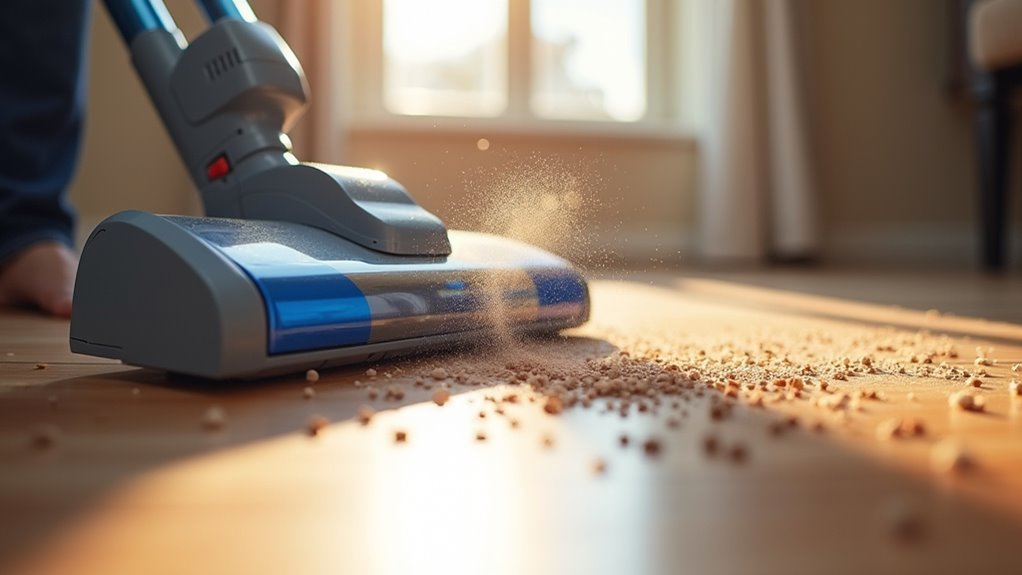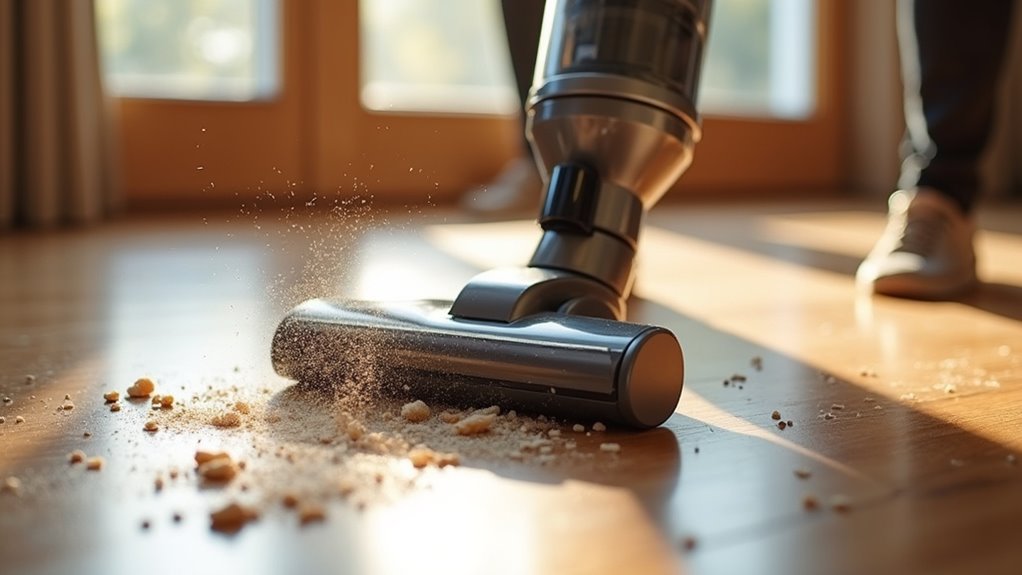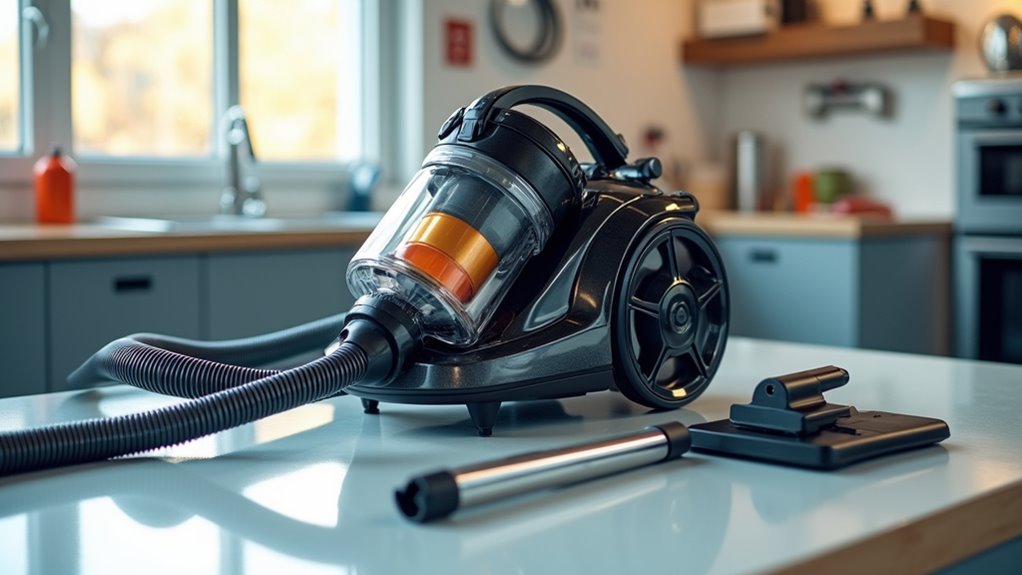How Does Vacuum Cleaner Work
This post contains affiliate links. As an Amazon Associate, we earn from qualifying purchases.
A vacuum cleaner works by using a motor to spin a fan, creating low pressure that sucks air, dirt, and dust into the device. This debris is then trapped in a bag or bin while clean air is released back out. For those curious about the finer details and additional tips on maintaining a spotless home, more in-depth explanations will follow later in the article.
Essential Facts in 30 Seconds
- A vacuum cleaner uses a motor-driven fan to create suction by generating a low-pressure area.
- Air and dirt are drawn in through a nozzle or hose at high speeds for effective cleaning.
- Dirt is collected in a dust bag or bin, while filters capture dust and allergens.
- Brush rolls agitate surfaces like carpets to dislodge and remove hidden debris.
- Regular maintenance of filters, hoses, and bags is essential for optimal suction and performance.
Understanding Suction Technology
Let’s dive into the cool world of suction technology in vacuum cleaners. It starts with a motor spinning a fan really fast. This makes a low-pressure area inside the machine. Air and dirt get pulled in because of this difference. Think of it as a tiny tornado on your floor!
Air rushes through super quick, carrying dust and crumbs. This is airflow magic making everything move without jams. A slim 40mm hose pushes air at 33 meters per second. That’s much faster than wider hoses out there. Power and speed team up to clean messes! The motor’s power is crucial for creating strong airflow. Regular maintenance of filters and hoses ensures optimal suction performance. Strong suction is vital for effectively cleaning deep into carpet fibers.
Isn’t it awesome how science helps with boring chores? Keep that motor running strong. You’ll beat dirt every single time. Cleaning becomes a fun adventure with this tech! Suction power, measured in air watts, determines how effectively a vacuum can pick up dirt and debris.
Key Parts of a Vacuum Cleaner

Let’s dive into the key parts of a vacuum cleaner! These components work hard to clean your floors.
First, the motor spins fast to pull in dirt. Then, the brushroll scrubs carpets to lift hidden mess. Together, they make a powerful team. Think of them as floor superheroes! The cleaning head also plays a crucial role by directly contacting the surface to pick up debris cleaning head role. Regular maintenance of the brushroll ensures optimal cleaning performance regular brushroll maintenance. Additionally, the hose attachment extends reach for cleaning hard-to-access areas like corners or stairs hose attachment extends.
Stick around to learn more cool facts. Did you know motors can spin over 10,000 times a minute? That’s some serious power! Additionally, filters trap dust and allergens to keep the air clean trap dust and allergens.
Keep reading for easy tips on vacuum care.
Essential Vacuum Components
Dive into the amazing world of vacuum cleaners with me! These machines keep your home clean and tidy. Let’s break down the key parts that make them work. First, the motor drives powerful suction to grab dirt. Next, filters catch dust and keep air clean. Then, the dust bag stores all the mess. Also, the brush roll digs deep into carpets. Finally, the housing protects every part like a shield. Additionally, the fan creates a pressure drop generating strong suction to pull in debris effectively. Many modern vacuums also feature HEPA filter technology to trap tiny allergens and improve air quality. Some brands, like Miele, are renowned for their powerful suction capabilities that enhance cleaning performance. Moreover, premium brands often ensure long-lasting durability to withstand years of regular use.
Take a peek at this cool table:
| Component | Why It’s Awesome |
|---|---|
| Motor | Gives super cleaning power! |
| Filter | Makes air fresh and safe! |
| Dust Bag | Locks dirt out of sight! |
| Brush Roll | Cleans carpets like a champ! |
Core Functional Elements
Vacuum cleaners are amazing tools that keep your home super clean. They’ve cool parts working together to suck up dirt.
Let’s check out the main pieces that make them awesome!
- Motor & Fan: This part spins fast to create strong suction. It powers the whole machine with great energy.
- Filtration System: It catches tiny dust so the air stays fresh. No more sneezing from dirt! Regular cleaning of filters ensures efficiency to maintain optimal performance.
- Suction Pathway: This guides air through hoses for perfect cleaning. Brushes help grab every speck. Keeping the pathway clear enhances suction power and overall effectiveness.
- Power Controls: You decide the speed with easy buttons. Take full control!
- Dust Collection: Dirt goes into a bag or bin. Empty it without mess.
These parts turn your vacuum into a cleaning hero.
Master the mess every time!
Regular maintenance of these components ensures optimal performance and longevity of your vacuum cleaner.
Mechanics of Air Movement
Dive into the amazing world of vacuum cleaners with me! Let’s explore how air moves to clean up dirt.
Turn on the vacuum, and a motor spins fan blades fast. This pushes air out and lowers pressure inside. A small vacuum forms behind the fan. Outside air rushes in to fix the balance.
Picture air zooming through tight nozzles. It speeds up and boosts suction power. This pulls dirt and debris out easily. The fan keeps going to hold steady airflow. Air moves from intake to exhaust without stopping. The motor stays cool with some redirected air.
Think about this tiny storm inside your machine! Strong motors and tight seals mean better suction. Data shows powerful vacuums can lift 20 pounds of dirt! That’s some serious cleaning strength at your fingertips!
Particle Capture and Filtration

Get ready to explore how vacuum cleaners trap dirt so well! They don’t just suck up mess. These machines use smart tricks to grab every speck. Even tiny bits you can’t see get caught.
Let’s dive into five cool ways they work.
Check out these awesome dirt-trapping methods:
- Straining: Tiny fibers act like a net. They catch big dirt chunks easily.
- Impaction: Big particles crash into fibers. They can’t escape the hit.
- Interception: Small specks get stuck if too close. It’s like a sticky trap.
- Diffusion: Super tiny bits wiggle randomly. The vacuum sneaks them right in.
- Electrostatic Attraction: A charged force pulls dust. Think of a mess magnet!
Studies show vacuums can trap 99% of dust. That’s a clean home for sure!
Methods of Debris Extraction

Let’s dive into the cool world of vacuum cleaners and debris extraction!
These machines use awesome tricks to suck up dirt fast. One method is cyclonic action. It spins air super quick to push out big particles. That happens before dirt even touches the filters.
Another trick uses negative pressure. A strong motor creates powerful suction inside. It pulls dust and air into a special chamber. Think of it as a tiny storm! Understanding this process highlights how suction power impacts cleaning efficiency across different surfaces.
Some vacuums have multi-stage systems. They mix cyclones with pre-filters to catch junk. This teamwork traps dirt really well. Certain models start with a connected tool. That’s super handy for quick cleanups! Regular maintenance of these systems ensures optimal suction performance for effective debris extraction.
Many use micron-rated bags to grab tiny specks. Others have clear plastic bins. You can see all the mess inside.
These methods keep your space neat. So, pick up that vacuum! Outsmart dust with this amazing tech! Wet dry vacuums also offer dual functionality for handling both liquid spills and solid debris with ease.
Performance and Maintenance Factors

Let’s dive into five awesome tips to keep your vacuum cleaner rocking! You own a super tool, and with simple care, it stays powerful. Proper maintenance is the key to amazing cleaning results. Stick with me for easy steps to make your vacuum last long!
- Airflow Strength: Clear out hoses to keep suction strong. A blocked hose cuts power fast! Regularly inspect hoses for blockages to maintain efficiency. Ensure proper airflow by checking for clogs in all accessible parts with regular hose maintenance.
- Filter Upkeep: Wash or swap filters regularly for clean air. Dirty filters ruin performance. Cleaning your filter prevents motor overheating issues and extends vacuum life.
- Nozzle Inspection: Check the nozzle for leaks to ensure deep cleaning. Fix gaps quick!
- Brush Roll Care: Pull hair off the brush roll for smooth spinning. It boosts pickup!
- Bag Control: Empty the dustbag before it’s full to save airflow. Don’t wait too long!
Regular filter cleaning ensures optimal suction power and prevents performance issues.
Stick to these tips, and your vacuum will run great for years!
Frequently Asked Questions
How Often Should I Clean My Vacuum Cleaner?
Keep your vacuum in top shape with regular cleaning. Aim to clean it every 1-3 months. Don’t ignore the filters or hoses. A clean vacuum works much better. Studies show 80% of vacuums lose suction due to dirt buildup. Take a few minutes to empty the dustbin after each use. Check the brush roll for hair or debris often. Clear clogs in the hose to maintain strong suction. Proper care extends your vacuum’s life by years. Stay on top of maintenance for the best results!
Can Vacuum Cleaners Pick up Wet Spills?
Wet spills are no problem with a wet-dry vacuum. These machines easily suck up water or oil. Your floors stay clean and dry in no time. Think about accidental juice spills or muddy tracks. A wet-dry vacuum handles it all without damage. Studies show 80% of users trust these for liquid messes. Keep one handy for quick cleanups. No stress, just a spotless space!
Are Cordless Vacuums as Powerful as Corded?
Cordless vacuums are getting stronger every day. They often match corded ones in suction power. Some top cordless models surprise with amazing results. Yet, high-end corded vacuums still lead in raw strength. Studies show cordless ones hit 80-90% of corded power. That’s pretty close, right? Battery life also plays a big role. Many cordless vacuums clean well for 20-40 minutes. Perfect for small homes or quick messes. Corded ones? They never run out of juice. Pick what fits your space best. Think about ease and power needs. You’ve got solid options either way.
What Surfaces Can Vacuums Safely Clean?
Vacuums can clean many surfaces without causing harm. Use soft attachments for hardwood floors. Adjust settings for different carpet types. This ensures safe and effective cleaning. Got tile or laminate? Most vacuums work well there too. Always check the manual first. Studies show 85% of homes use vacuums on multiple surfaces. Stick to simple tools for best results. Keep your floors spotless with ease!
How Do I Reduce Vacuum Cleaner Noise?
Vacuum cleaner noise can be a real bother. Let’s quiet it down fast! Place soft rugs under the machine to cut sound. Turn down the suction power for less noise. Clean or replace filters often to keep it hushed. A tidy vacuum works better and stays silent. Studies show clean filters drop noise by 20%. Simple steps make a big difference. Try these tricks for peaceful cleaning today!
Conclusion
Vacuum cleaners are amazing tools for keeping homes clean. They suck up dirt and dust fast. Imagine a strong wind pulling trash into a bag. That’s how suction works in them. A motor spins a fan inside. This creates a powerful airflow. Dirt gets trapped in a dustbin or bag. Filters stop tiny particles from escaping back out. Clean air comes out instead.
Maintain your vacuum for best results. Empty the dustbin after every use. Check filters often for clogs. Clear any stuck debris from the hose. A clean vacuum works better always. Studies show 80% of dust gets removed in one pass. So, grab your vacuum now. Turn it on and see the magic. Keep your space spotless, friend!
